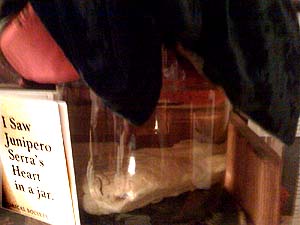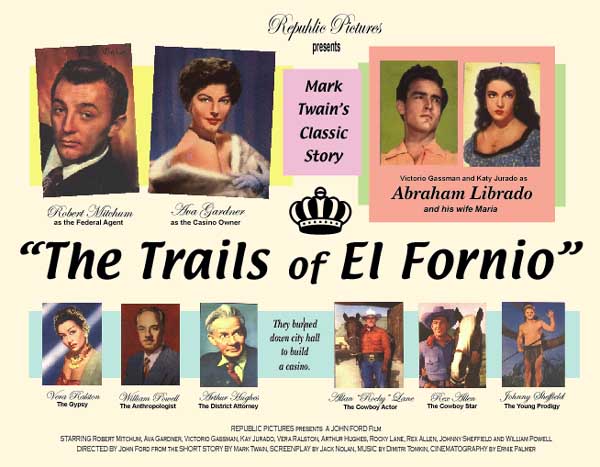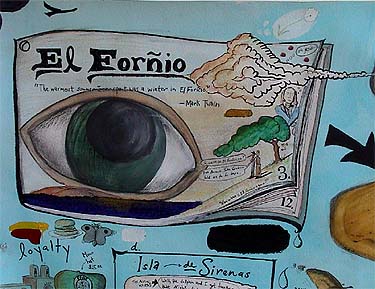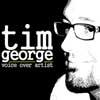At
least, that’s how I imagined it happening—the theft
of the heart. To be honest, that’s how I wrote it. As
the curator of the El Fornio Historical Society and a trained
archeologist, I had taken the amateur historian part of my
career and hitched it to my nearly legitimate career as a
curator.
That’s how I became a fiction writer.
As a side project I had been writing an account
of Father Junipero Serra’s heart
as it chugged its way through California history. Actually,
I kind of had to write it because my “cousin” was
discouraged by my lack of interest in the subject. As the
curator of the historical society—and a close friend
of the local Indian tribe—I was, in her opinion,www.multiluxury.com in a
position to be more empathetic to the tribe’s interest
in the heart. So I began the story six months ago, beginning
the narrative in 1789, the day the old boy’s heart was
taken from his unwarming corpse, slipped into a ceramic jug
filled with brandy, and rode away on horseback.
Believe me, I have been completely realistic
about the difficulties of writing a book—especially about
the marinated heart of a Spanish padre. Even if it turned
out to be any good, “The History of Junipero Serra’s
Heart in a Jar,” conceived without a single car chase
scene or radio pop anthem, seemed at best a gentleman’s
pursuit, a stoned idiot’s collection of doodles writ
upon a dozen moleskins.
I often thought of just dumping all the research
into a lightly written travel guide. I already had all the
pictures and text.
A Drive Down 101 was my working title.
You see that kind of fluff all the time in the bookstores.
Recipes from the California Missions or Great Hidden
Trails in Your Own Backyard, Vol. 4 (which aren’t
hidden anymore if you write about them.) Somebody was making
a career out of this stuff. So I, of course, asked the question
that shouldn’t be asked: Why wasn’t I doing it?
I mean, why sweat the literary thing when I could just plug
the whole project into captions and photos?
Collecting the necessary flotsam to write a book
made me no different than anyone else in the state. Throw
that many half-educated people into one society and they’re
all going to think they have a book to write. Some even get
around to doing it— then one day when they walk away
from it, their kids find tomes-in-drawers next to half-loaded
revolvers.
Which I didn’t want.
So I decided to take a serious stab at my cousin’s
proposal to write about the heart because—until it was
stolen—she was right: I barely noticed it.
Maybe it was because it got lost in all the other
bric-a-brac the previous curators had collected over the years.
I only saw my own collections, my own point of view of history
through the historical society. For my cousin, who was part
Indian, the heart in the jar was like a rosetta stone amongst
bricks and mortar. For me, it was like a another pinpall machine
with a theme—and I wasn’t really into the theme.
At least not at the time.
Except for Junipero Serra’a heart in a jar,
The El Fornio Historical Society was no different than any
other historical society in the state. We had a collection
of Indian things and European things. The Indian things we
had, the artifacts to be professional about it, were
objects the local Fornay Indians hadn’t managed to reclaim
through the dozen or so court orders issued through the decades.
We had your usual grinding stones, arrowheads, bone flutes
and needles. Nothing particularly special.
Technically, the Native American stuff we had
was here because it was never assigned to any particular tribe.
We all knew the collection was Fornay—everybody did—but
by never designating it, the historical society was able to
hold on to the modest collection it did have. It was territorial
pissings enough that we had Serra’s heart in the jar.
The Indians so wanted it but knew—by an agreement going
back to 1926—that if the heart stood under the roof of
the historical society, it was our’s. But there will
always be plenty of time. The afternoon the grail was walked
out of the building, a big game of grown-up finders-keepers
was under way.
I was in my office that day, upstairs, a Friday,
scribbling away about the holy pumper’s narrative, circa
1876, trying to focus my writing of the book against the backdrop
of the week-long Old Spanish day festival getting started
outside. Even a dedicated bachelor scholar like myself, playing
Mr. Writer, had to throw in the towel. Three skyrockets shot
by the window and burst their innards against the glass
(laiizez faire El Fornio had never outlawed the blasters—too
many Chinese and Indians . . . Mexican and Irish, Japanese,
Croatians—you name it.)
Figuring why be burned alive in an old wooden
Victorian full of dusty jars of formaldehyde, I stopped writing,
cleaned up, and went out for a drink. Was the back door locked?
Was it not locked?
I wondered.
The whole town was about to descend into its
annual ritual of smokey barbeque, horsey parade and drunken
revelry—not an afternoon that seemed like someone would
sneak in and take an old padre’s pickled heart.

My name is John Peabody—John
Henry Peabody. Like Robert Plant shouting, “John
Bonham! John Henry Bonham!” at Zeppelin’s
`75 Madison Square Garden show.
But not.
For the most part, people called me Hank. I don’t
even look like Robert Plant. My hair was dark, when I had
it. My beard was scruff but trim to balance the strandy pate
I mentioned growing above my eyebrows.
As for Peabody being my last name, it pretty
much summed me up as a boy, second-string linebacker-type,
resilient, but continually knocked on my ass by the larger
guys. In baseball, I loved playing catcher, even as the gear
quietly suffocated me. I could do it, sure—but a throw
to second base usually ended up in the back of my head, between
my hair and the straps, the mask, shin guards and chest protector
pulling me to Earth.
It was only through much concentration, steak-eating,
beer drinking, body surfing, trailblazing and what passed,
in my case, for girl chasing, that I made it to five feet
nine inches tall (it was probably eight, but I kept with the
nine, anyway).
Half way through college, I was more body than
pea, finally.
I’ve now been the curator of the El Fornio
Historical Society for the last two years. My specialty was
Native American coprolites—from the Greek, “dung
stone”—which, yes, made me a high-falluting shit
collector.
My science was collecting poop from people who
had been dead for hundreds to thousands of years. I examined
poop so that others might know something about dead people
and what they pooped when they pooped it.
The Neverending Poop, I called it. While not
exactly as fossilized as dinosaur remains, the term’s
origin, the ancient scat I relished was nearly always dried
to perfection, just waiting for me to come along, manipulate
and catalog it.
Catalog?
As you can imagine, being an expert on Native
American coprolites was a real panty dropper. Take a girl
back to your place and see how she reacted to that esoteric
specialty. Maybe that was why I have been single for the better
part of a decade. One person’s scientific specialty was
another person’s gag reflex. While a lot of people could
take the ladies to their den and show them arrowheads and
mysterious shamanic totems, all I had was a vast and well-footnoted
collection of dried up indigenous litter with which to hypnotize
the local mädchen. As Spongue Bob Square Pants once said,
“Good luck with that!”
Yeah.
I was born in El Fornio, California in March
of 1962. I was one of those fishy Pisces let loose along the
California coast, just south of San Luis Obispo and north
of Santa Barbara. I went to El Fornio High School—where
I was a Moor—and got both my undergrad and graduate degrees
from the University of California at Santa Barbara, where
I was a Gaucho. My mother, Elizabeth McCandy Peabody, from
Nebraska, lived until I was twelve years old when she was
killed in a car accident with the mother of a school friend
of mine. My father, the well-known and occasionally disparaged
California ethnologist, Francis Henry Peabody, PhD., died
after my fifth birthday.
A trained linguist and ethnologist, old “FHP,”
as he signed his name, documented the vanishing languages
and cultures of California Indians throughout the 1920s to
the late 1950s. Some two thousand wax cylinders and magnetic
tapes of Southwestern and California Indian languages are
attributed to his fieldwork. Completely dedicated to his career,
to the point of eccentricity, it has been generally accepted
that Francis Henry Peabody—my old man—went a bit
“native” at the end of his life.
In a notorious front page, lower left (or second
section top right) news story—depending upon the paper
you read—Dr. Frank Peabody died at the home of the Saticoy
sisters, Linda and Hermosilla, Central coast Indians whose
mother was one of my father’s original informants. He
was found in a sweathouse built out back of the sisters’
white Victorian, dressed in a loin cloth with shell beads
and stone fetishes hung from his neck.
A formal man who wore slacks and a blazer everywhere
he went—even into the field—Frank Peabody had stopped
shaving in the last year of his life, given to wearing native
costume and body markings in pursuit of what I’m assuming
to be his final anthropologic quarry. Although the coroner’s
records say he died of a heart attack—which at eighty-one
years old, raised on an early twentieth century American diet,
was not surprising—most accounts suggest that the night
of his death my pops was pretty high on datura or toalache,
the Indian psychoactive used in religious rituals for centuries.
However you want to think about it, my father took his work
seriously. How many white guys of his generation died like
that?
When I signed on to the job of director and curator
of the El Fornio Historical Society, I had some pretty clear
intentions. Although I had only met my father once—when
I was five (I don’t remember it)—I was determined
in some hazy way to continue his work, aside from the loincloth
get-up.
After ten years in Santa Barbara and Ventura,
doing Environmental Impact Reports for the county as well
as archeology for private firms like James & Doore, Native
Reclamation, and Malibu Flute Expansions, I had seen my career
get completely sidetracked. Every time a movie guy in Montecito
put a hot tub or putting green in his back yard, they would
call me in. I’d sit there, chewing gum, drinking Dr.
Pepper, waiting for the backhoe to dig up some ancient local.
On site with me would be an NA, or Native American—sometimes
called a CLR or “Closest Living Relative.” One thing
NAs were good for, I always said, was gum, soda and menthol
cigarettes, most of which I never imbibed in. But once in
awhile, your career in the shits, a couple of sticks of gum
and a Dr. Pepper were the only things between you, a cigarette
and oblivion.
I always had a studious eye pealed for my specialty.
The occasional short log stuck in the dirt—almond roca
from 236 A.D.—shined to me like a Spanish coin. Mostly
when you worked county and private firms, you paid attention
for ribs and kilter, skull caps and shell, ash, dust, people
stuff that suddenly presented itself under the weeds. I knew
ancient log like no one.
In 1991, after mostly finishing my dissertation
at the University on “Central Coast Native American Coprolite
Densities,” then putting in a few odd years of EIRs,
I could definitely say my career was twice as shitty as when
it began.
In those days, I would apply for assistant curator
positions at places like The
Santa Barbara Museum of Natural History or Director of
Archaeology at the Channel Islands Historical Society.
No luck. Once I applied to be curator at the
Goleta Train Museum (I liked trains well enough),
but eventually I just couldn’t bare the thought of driving
a miniature locomotive around for kids on weekends, dressed
in overalls and a conductor’s hat. I also realized that
after years working the area, Santa Barbara had its own caveats.
There was only one of anything in town. So once you were it,
that was it. If you weren’t anymore, you weren’t
it—and you could never be it again. Since I had never
even been it once, I was happy to get my stuff and go.
To be honest, it was pretty clear that no one
was interested in an expert on dried turds, even if they were
Native American turds—and it wasn’t like I wasn’t
invested. I was prepared to donate my Central Coast coprolite
collection to any one of the institutions I had applied to.
They were nice display cases, real glass and
mahogany (how much is real glass and mahogany anymore?). Most
people didn’t even know they were looking at dried scheiss
unless you told them. They just figured they were gazing at
important artifacts—which they were. Whole families placed
their hands on the wooden and glass cases and went, “Wow!”
while gazing at my work.
The afternoon that Serra’s heart was taken
from the historical society—also known as my office—I
imagined, and was pretty sure, that the heart and its liberateur
headed out of the building and in the direction of the growing
party. Together they would have eyed the wooden stalls of
tamales, olive oil, T-shirts, cheeses, lettuce, tri-trip sticks,
wheat grass shots, and Bear Republic flags on margaritas.
The old padre’s carburetor passed the apple-smoked
sausage and chorizo stall put on by the local Jaycees. It
floated by the century old Aliso-Kennedy
brand tomatillo salsa booth. Through the streams of Friday
night festival-goers, the heart made its way up the avenue
in rhythm with the bandit’s stride. Together they passed
children in red, yellow, black and green uniforms, dresses
and vests ironed for the parade now a bit unbuttoned and wanting
to go home, to play with friends . . . A skyrocket whistled
into the air from behind a fence and beer bottles broke with
drunken laughter as the rocket cracked, sending sparks flying
all around. A man in a pelican costume sauntered waist-high
amongst the crowd. He waved to the crew on the patio at the
Rusty Pelican, deep into their fourth round of Rob Roys where
a band clanged out a hazardous version of “Walk Don’t
Run.”

“Hey, Sean!” one of them leaned over
the rail, waving.
Sean Heany, music
critic for the local “Daily Breeze” paper, pelican
mascot around town, shorter than anyone you’ve ever seen
and a man worth knowing, was making his Friday late afternoon,
early evening rounds.
“Keep it up, Heany,” I toted.
Sean saw me and nodded with a knowing Heany scowl.
Everyone had shown up for an Old Spanish Days inoculation
and Sean was ready to administer it. That’s what he did.
The pelican spiraled his arms with the feather
coverings of his proxy wings. “This should keep everything
cool,” he said, feathers fluttering in the dusky heat.
The crowd cheered him.
I knew that I would be back to the Rusty Pelican
in the next hour or so, but right now I had to walk through
the droves, conducting my annual stroll down Main Street to
see just how dazzled everyone was getting. And Dazzled was
what they got on Old Spanish Days (also known to the locals
as “Old Spicked Out Gays”).
Every year, in the first week of August, the
town threw its annual festival, drawing tourists up and down
the coast in the hopes that they would spend their time on
paper cups, plastic hats, grilled fauna and the narrative
fantasies of adjacent history.
Protesters to the event claimed the scene to
be “White people dressed up like the Mexicans they displaced,
dancing on the graves of the Indians,” which was kind
of true. But a lot people at the annual festival were rich
in melanin and a lot of Indians who lived up in the Pass had
never died, and some people, the tour guides proclaimed—cameras
flashing—were “dressed in the manner of the great
days of the Spanish Californios, right down to the
silver belt buckles.”
Whatever. Everybody had their own story to tell,
but any attempt to define the area was always incomplete as
it was a slippery business to begin with—born out of
a slippery history. Just as winter mudslides had continually
changed the topography of the adolescent geology, a moving
in and out of peoples had continually changed the face of
the locals. After picking up everybody’s shit for the
last two thousand years, I liked to think that I had a pretty
good picture of who everybody was around here. Only later
did I find that I only had an inkling.
In my case, I had always thought of myself as
a teenager in permanent state of wonder. I think you need
that to be in my profession. In fact, you needed it to be
Me. I had spent so much time wondering about the deaths of
my mother and father that wonder became a state of being.
I wondered what it would have been like to grow up with my
father. I wondered what it would have been like if my mother
wasn’t killed in an accident. I wondered if anyone was
going to figure out that I had never, technically, finished
my degree.
I just plain wondered.
My wondering could get the best of me. The Hollywood
director, John Ford, who directed Mitchum and Ava Gardner
in Mark Twain’s “The Trails
of El Fornio,” knew about my father’s work through
his relationship with the Indians he had been casting—and
shooting off of horseback— for years.
In “Trails,” he cast William Powell
as “The Anthropologist,” which was a nod to my old
man. In some of the scenes shot in downtown El Fornio, you
can see my father standing in a crowd listening to the actor
Victorio Gassman, portraying the great Abraham Librado, chief
of the Fornay for most of the twentieth century.

In these scenes, my father was tallish, thin,
dressed in ill-fitting trousers and a blazer looking slightly
unfocused. Powell, portraying my father, stands in the foreground.
The look on my father’s face, ever the observer, seemed
to be saying how lost he was standing in a fiction, looking
at the man he was being portrayed by, while at the same time
being himself looking at the people he knew to be real set
amongst all the actors. My father, from what I heard of him,
made his career getting at the core of a person’s nature,
their narrative. Movie-making, as much as he might have appreciated
it, was one, even two steps back from the reality he was after
. . . These thirty seconds of him shifting and blinking his
eyes as a movie extra were the only animated record I have
of my father. I am the only person in the world that knows
that I watch this scene four or five times a year. And if
I have enough beers in me, I wonder until the tears run down
my face.







